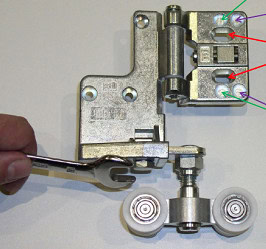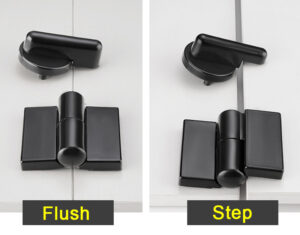When it comes to environmental test chambers, environmental test chamber hinges play a crucial role in maintaining the integrity and accuracy of test results. Hinges are responsible for holding the door in place. Ensuring a tight seal, and facilitating the opening and closing of the chamber.
However, selecting the right hinge type, material, and load-bearing capacity. And the frequency of use is critical for ensuring optimal performance and reliability. In this essay, we will explore six key questions related to environmental test chamber hinges. And discussing the factors to consider and their implications for chamber performance.
What is an environmental test chamber?
An environmental test chamber is a specialized piece of equipment designed to simulate various environmental conditions for the purpose of testing the performance and durability of products and materials. These chambers are used across a wide range of industries. Including aerospace, automotive, electronics, and medical device manufacturing.
Environmental test chambers can replicate conditions such as extreme temperatures, humidity, vibration, and even exposure to saltwater and corrosive gases. They are used to test the reliability, quality, and safety of products in real-world conditions before they are released to the market. By subjecting products and materials to controlled environments, manufacturers can ensure that they will perform as expected in the intended conditions. Which ultimately improves product performance and reduces the risk of product failure.
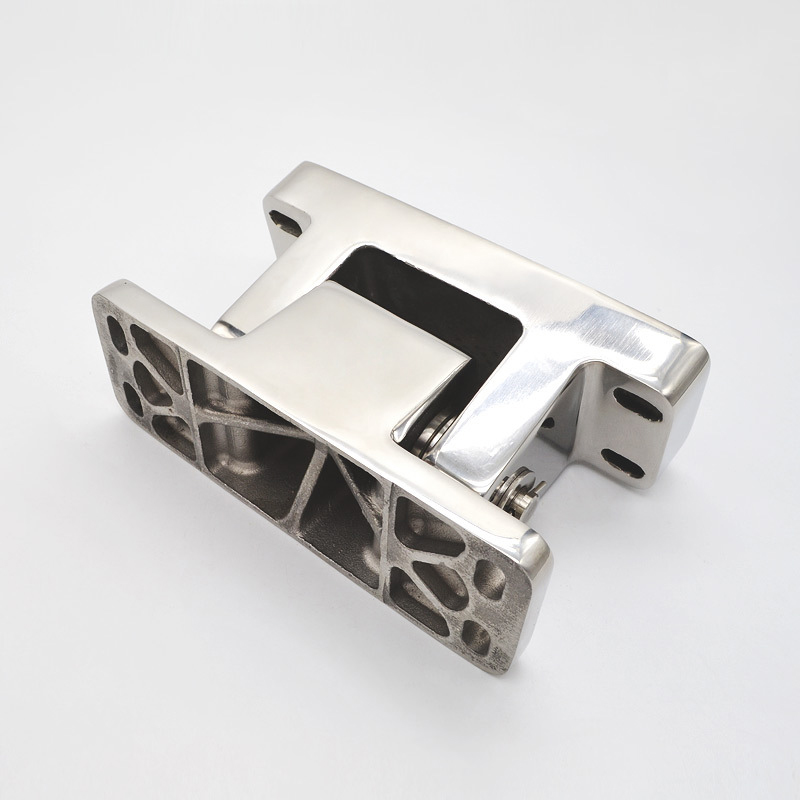
What factors should be considered when selecting hinges for an environmental test chamber?
Several factors should be considered when selecting hinges for an environmental test chamber, including:
Hinge type: Different types of hinges are available for environmental test chambers, such as piano hinges, butt hinges, and continuous hinges. The type of hinge selected should be based on the specific application, load capacity, frequency of use, and other requirements.
Material of construction: Environmental test chamber hinges are typically made of stainless steel, brass, or aluminum. The material of construction should be selected based on the environmental conditions inside the chamber. Such as temperature, humidity, or exposure to corrosive substances.
Load-bearing capacity: The hinges should be able to support the weight of the door. Which is especially important for heavy or large doors. The load capacity of the hinge should be selected based on the weight of the door. And it is important to avoid hinges with a low load capacity that can bend or break under the weight of the door.
Frequency of use: The frequency of use is an essential factor to consider when selecting hinges for environmental test chambers. If the chamber is used frequently, such as in a production environment.
Door seal: The door seal is critical for maintaining the controlled environment inside the chamber and preventing the escape of moisture, temperature, or other environmental factors.
Maintenance: Proper maintenance and inspection of hinges are essential for ensuring the reliable operation of environmental test chambers. Hinges must be inspected for wear, damage, or corrosion, and lubricated regularly to maintain smooth and reliable operation.
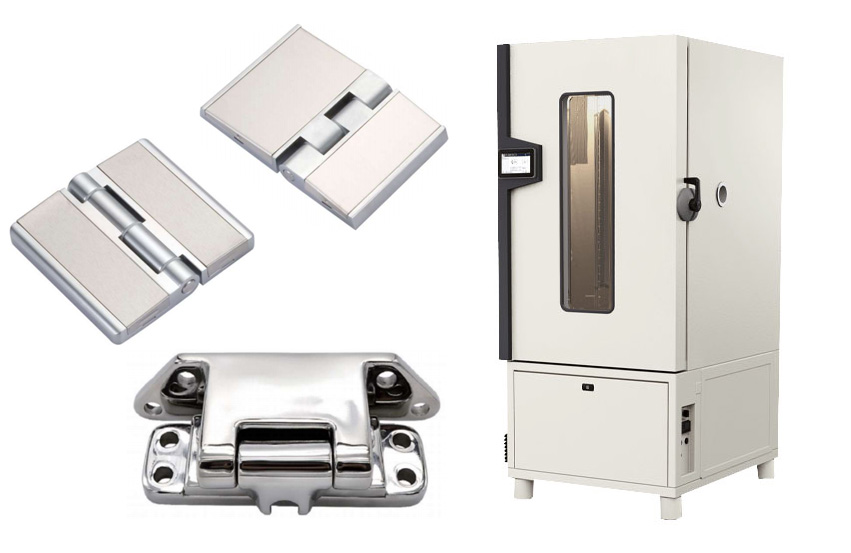
Why is the load-bearing capacity of hinges an important consideration for environmental test chambers?
The load-bearing capacity of hinges is an essential consideration for environmental test chambers because it determines the weight that the hinge can support. Environmental test chambers often test heavy or large equipment, and the hinges must be able to support their weight.
Using industrial hinges with a low load-bearing capacity can lead to bending or breaking under the weight of the door, which can cause door misalignment and seal failure. This can result in leaks and a loss of control over the environmental conditions inside the chamber, compromising the accuracy of the test results.
To prevent such issues, it is essential to select hinges that have a load-bearing capacity that matches the weight of the door. The load capacity of the hinge should be determined based on the door size, weight, and any additional equipment that may be added to the door. Selecting hinges with a higher load capacity than required can also be beneficial, as it provides an extra margin of safety and can prevent premature hinge failure.
What are the consequences of using hinges with a low load-bearing capacity in an environmental test chamber?
Using hinges with a low load-bearing capacity in an environmental test chamber can have severe consequences for the chamber’s operation and accuracy. When the hinges are unable to support the weight of the door, they can bend or break, causing door misalignment and seal failure. This results in the escape of moisture, temperature, or other environmental factors, and a loss of control over the chamber’s internal environment.
The consequences of using hinges with a low load-bearing capacity can be significant, including the need for more frequent maintenance and replacement of hinges, as well as the potential loss of test accuracy and validity. Furthermore, if the chamber’s internal environment is not well controlled, it can impact the equipment and specimens being tested, leading to damaged or inaccurate results. The use of low-capacity hinges can also lead to increased energy consumption and associated costs, as the chamber’s cooling or heating system must work harder to maintain the desired conditions.
Therefore, it is crucial to select hinges with the appropriate load-bearing capacity, considering the weight of the door and any additional equipment. This ensures the longevity of the hinge and the accuracy of the test results while minimizing the maintenance requirements.
How does the frequency of use affect the selection of hinges for environmental test chambers?
The frequency of use is a critical factor to consider when selecting hinges for environmental test chambers. If the chamber is used frequently, such as in a production environment, the stainless steel industrial hinges must be durable and reliable, and able to withstand frequent opening and closing cycles. In contrast, hinges designed for low-frequency use may not be suitable for high-frequency applications and may wear out quickly or fail to maintain proper door alignment.
The frequency of use can also impact the selection of the hinge type, material, and maintenance requirements. For example, if the chamber is used frequently, stainless steel or brass hinges may be a better choice than aluminum, as they are more durable and resistant to wear and corrosion. Hinges with grease fittings or other lubrication features may also be preferred for high-frequency applications, as they require less maintenance and provide smoother and more reliable operation.
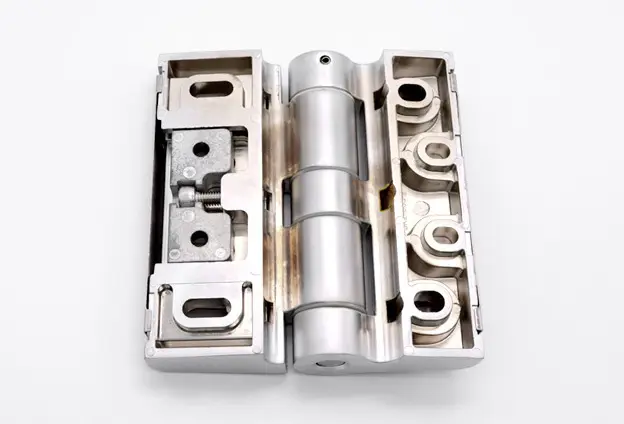
Why is the door seal critical for environmental test chambers, and how do hinges contribute to maintaining a reliable seal?
The door seal is critical for environmental test chambers, as it prevents the escape of moisture and temperature. Or other environmental factors, and maintains a controlled environment inside the chamber. The door seal is established through the use of gaskets. Or seals installed around the perimeter of the door. Which is compressed when the door is closed to provide a tight seal.
Hinges contribute to maintaining a reliable seal by ensuring proper door alignment. And minimizing door deflection. Proper door alignment is crucial for achieving a tight seal. As any misalignment can cause gaps or leaks in the door seal, compromising the controlled environment inside the chamber. Hinges that are not properly aligned or are unable to support the weight of the door can cause door deflection, leading to gaps in the seal.
Therefore, selecting the right industrial oven hinges type, material, and load-bearing capacity. And maintenance requirements are essential for ensuring optimal door alignment and minimizing deflection. Additionally, regular inspection and lubrication of hinges are essential for maintaining proper operation. And preventing wear and tear that can cause misalignment and seal failure.
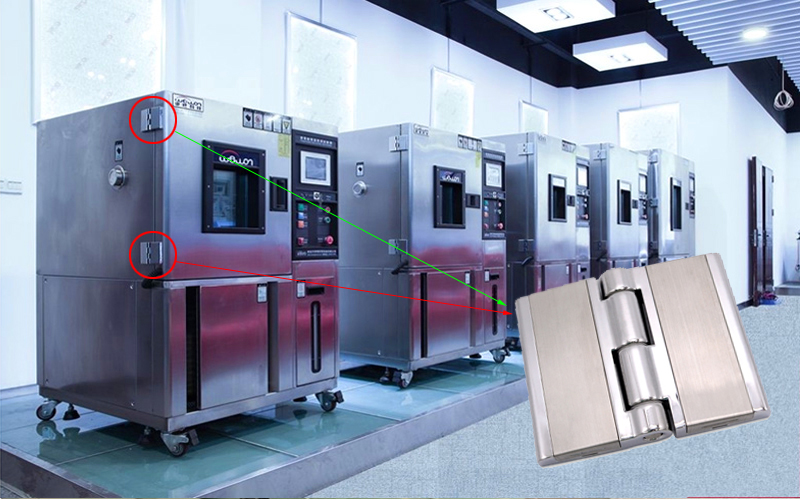
What is the importance of regular maintenance and inspection of hinges for ensuring the reliable operation of environmental test chambers?
Regular maintenance and inspection of hinges are essential for ensuring the reliable operation of environmental test chambers. Hinges that are not properly maintained or inspected can lead to misalignment, seal failure. And decreased accuracy and validity of test results, and may also result in increased energy consumption and associated costs.
Regular maintenance and inspection of hinges should include the following activities:
Lubrication: Hinges should be lubricated regularly to prevent wear and tear and to ensure smooth and reliable operation. Lubrication should be performed using a high-quality lubricant that is compatible with the hinge material.
Inspection: Hinges should be inspected regularly to identify any signs of wear or damage, such as cracks, rust, or bending. Any damaged or worn hinges should be replaced immediately to prevent misalignment and seal failure.
Load-bearing capacity: The load-bearing capacity of hinges should be verified regularly. To ensure that they can support the weight of the door. And any additional equipment. If the hinges are unable to support the weight, they should be replaced with hinges with a higher load-bearing capacity.
Alignment: Hinges should be inspected regularly to ensure that they are properly aligned. And that the door is not deflected. Any misalignment should be corrected immediately to prevent gaps or leaks in the door seal.
Cleaning: Heavy-duty butt hinges should be cleaned regularly to remove any dirt, debris, or corrosion that may affect their operation. A mild detergent solution and a soft-bristled brush can be used to clean the hinges and remove any debris.
IHINGES Conclusion
In my experience, the selection, installation, and maintenance of hinges are critical to reliable operation. And accuracy of environmental test chambers. Proper selection of hinges based on load-bearing capacity and frequency of use, regular maintenance. And inspection of hinges, and maintaining proper alignment and lubrication can help prevent misalignment, and seal failure. And decreased accuracy and validity of test results. Regular maintenance and inspection of hinges should be included as part of the chamber’s overall maintenance program. To ensure the longevity and reliability of the equipment.

